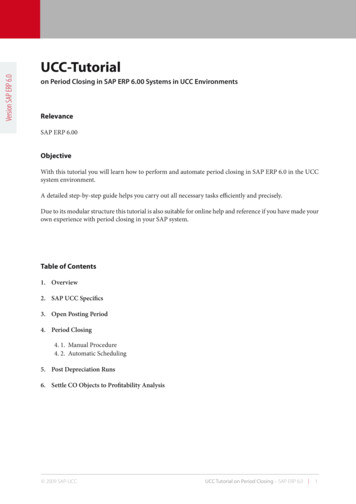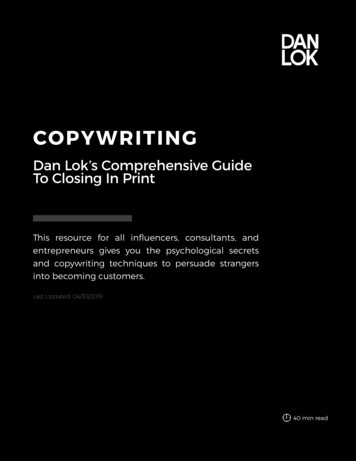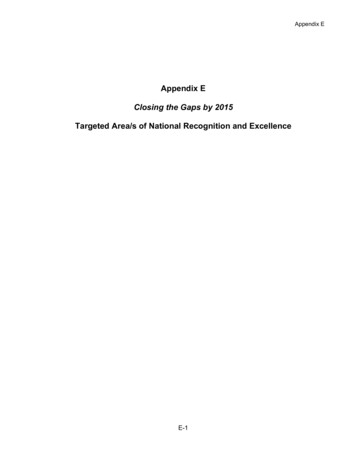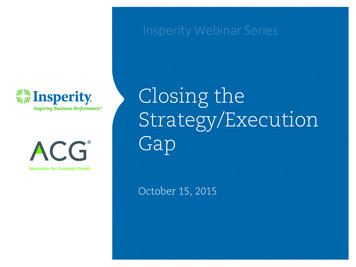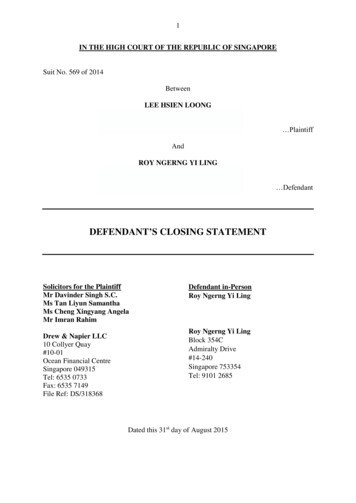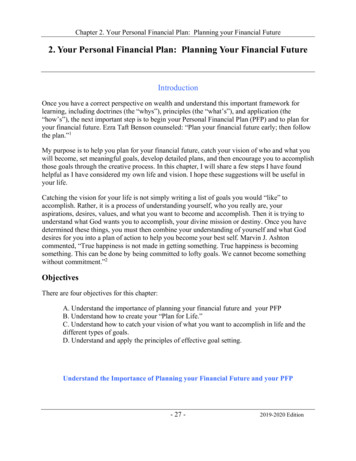
Transcription
Advanced Financial ClosingAutomate, process and monitorclosing processes with a single cloud hub
Advanced Financial Closing Automate, process and monitor closing processes with a single cloud hubAdvanced Financial ClosingA single solution to automate, manage and steer all closing processes of anenterprise ensures efficient and auditable financial closing and reporting. SAPrefined the solution for close orchestration, providing a closing hub in the cloud forall corporate entities, regardless of their operative accounting system.Today large groups use a varietyof software tools to streamline thefinancial close process, because closingcalendars based on spreadsheets orreconciliations between companiesusing the same lack speed, efficiencyand auditability. Especially with Covid-19,forcing employees to work from home,the orchestration of the closing processsteps and tasks has become even moreimportant than ever.Changed ExpectationsWe live in an age where modern technologylike robotics and artificial intelligence are nolonger science fiction, but ubiquitous. Notonly tech companies use these for examplein the marketing department to monitorsocial media sentiments and web browsingbehaviors to tailor offers accordingly. Thisalso holds true for the modern financedepartment, as 2% of FP&A functionsand 7% of shared services have alreadyadopted AI and in the coming years 88%of corporate controllers will use roboticsprocess automation according to Gartner,a research company. These developments2have changed the expectation towards thefinance function. Up-do-date informationshould be immediately available to supportbusiness decisions. Automation of mostfinancial reporting tasks on the one hand,and the use of predictive analytics andsimulations on the other, allow businessesto create snapshots frequently froma financial reporting as well as from amanagement accounting perspective. Toachieve that, the original function of thefinance department, closing the books andstatutory reporting, has to become a nonevent.Orchestration and automation leadsto closing as a non-eventThe closing process of a large group iscomplex, as it can involve hundreds oflegal entities and personnel, possiblyoperating with a disparate ERP systemarchitecture. Closing the books canonly become trivial if many tasks canbe automated, their interdependenciescontrolled and the personnel beorchestrated efficiently and effectively.One solution developed by SAP forthis purpose is SAP S/4HANA Cloud forAdvanced Financial Closing (AFC). TheCloud-based solution can orchestrateproduction systems running on SAP ERP6.0, SAP S/4HANA (AnyPremise and Cloud)and will enable integrated scenarios withnon-SAP systems in the future.Financial Closing HubAFC acts like a launch control center for allentity closing processes within the group,covering closing tasks like depreciationof noncurrent assets, posting of reservesor intercompany reconciliation. Itprovides a platform to automate as manytasks as possible (e.g. triggering of thedepreciation run) and to orchestrateaccounting personnel involved (e.g. inthe intercompany reconciliation). In thenext years, SAP plans to integrate AFCwith Group Reporting, offering a holisticsolution framework.Already one step further with SAPS/4HANAFor Companies already using SAPS/4HANA as an operational ERP system,some closing steps of the legal entityclose are no longer necessary, as theUniversal Journal integrates the GeneralLedger with the subledgers (AccountsReceivables, Accounts Payables, AssetAccounting) and with the cost accountingmodule. The previously requiredreconciliations are eliminated by the newdesign. If reconciliations or other manualtasks are necessary, AFC can provideworkflow support, identify process errorsand blockers and monitors the overallprogress of the entity close.
Advanced Financial Closing Automate, process and monitor closing processes with a single cloud hubBenefits of SAP S/4HANA Cloud forAdvanced Financial ClosingTemplates ease the definition of theclosing processAFC comes with pre-configured task listtemplates for S/4HANA releases thatdepict standard closing steps (AccountsPayable, Accounts Receivable, AssetAccounting etc.) as well as meaningfulsequences and dependencies betweenthose steps. Furthermore, manual taskscan be included as standard operatingprocedures including approval-basedcontrols to ensure compliance.Fig. 1 – Main Benefits of AFC15–25% FasterClosing cycle(SAP PerformanceBenchmarking)Task TemplatesCollaborations& NotificationsWorkflows &AutomationProcess all closing tasks in a singleenvironment and save time withautomationAccountants use the Process ClosingTasks app to trigger closing tasks insideAFC and to schedule or automate jobslike depreciation runs. Because of the setdependencies, automated succeedingtasks will run through. The app updatesthe status of the tasks automaticallyfor proper monitoring. Collaborationfeatures facilitate the communicationwith all employees involved in the closingprocess – with workflow and calendarreminders for accountants that have todo manual analysis tasks. Critical closingtasks can be approved by the managerwith the Approve Closing Tasks app.Monitor the status of the closingprocess in real time – from the wholegroup down to a specific task of asingle entityBecause the orchestration of thewhole closing process is tracked in AFC,managers can monitor the process inthe Financial close overview KPI-baseddashboard which shows open tasks, tasksto be approved, delayed tasks, completionrate, number of errors etc. to empowerthe manager to take immediate action.Fig. 3 – Accounting Managers canmonitor the process in the FinancialClose Overview appFig. 2 – Critical closing tasks can beapproved by the Accounting ManagerAudit TrailMonitoring& AnalyticsThe template can be used “out of the box”or customized to individual needs. Thecritical path can be set manually or bedetermined automatically by the system.The finalized template can be used togenerate task lists for a specific entityclose (e.g. close 06/2020) and will steer theclosing process.Accountants are provided with anindividual task list and a status barindicating the progress and status oftheir closing steps. For tasks like thereconciliation of Goods Receipt/InvoiceReceipt (GR/IR) the accountant can usebuilt in analytics features visualizingtask related figures in a dashboard likeIR Amount Surplus or the number ofpurchase documents where the amountsof Goods Received equal the amounts ofthe Invoice Received.3
Advanced Financial Closing Automate, process and monitor closing processes with a single cloud hubThe road to Advanced Financial ClosingProject Approach for AFCImplementationWe work closely together with SAP toensure a successful implementationof AFC and propose to set up theproject with two workstreams. The firstworkstream will organize workshops withthe finance department to analyze thecurrent closing process landscape and tosupport adapting the SAP template to yourindividual needs. The second workstreamwill support with the technical migrationand system settings.Our vision for continuous accountingOrchestration and automation of theentity closing processes are the firststeps towards a finance function of thefuture, as they free up time to look whatlies ahead instead of looking in the past.Prediction and simulation methodsprovide more accurate insights about thedata “still outstanding” in the period. AndSAP S/4HANA already supports predictiveaccounting scenarios to predict expectedrevenues using sales order information.The finance department will be able togenerate balance sheets and profit andloss statements many times during themonth to provide managers early insightfor course-corrections and steering.we can migrate the template. Afterwardswe will work in parallel with the SAP teamto set up AFC. The Deloitte team willsupport with the set up of the templatein AFC, the SAP team will register clientprograms and users. In the succeedingphase end users will be trained andprovided with manuals. The project willbe deployed with user support during thefirst close using AFC.A vision is only as good as a clear planof action to realize it. After laying solidground with an orchestration andautomation solution, a next step couldbe to further automate manual tasks.This can be done with intelligent RoboticProcess Automation to automate chainsthat include several steps in differentapplications (e.g. checking a mailbox, usingan excel attachment, and posting in SAPFI) and require cognitive abilities.Another example is GR/IR reconciliationwith machine learning in SAP S/4HANA tohelp automating the reconciliation of itemsthat do not match because of amountdifferences, and trigger automatic writeoffs of differences not exceeding a definedthreshold. Regarding the automation ofthe intercompany reconciliation process,SAP Intercompany Hub by BlackLinecan be added to ease the reconciliationacross currencies and geographies in aheterogeneous systems environment.In the initial project phase we check theSAP closing template against your currentclosing processes. The Fit/Gap analysis willbe used to modify the template to yourneeds. If you already use the SAP FinancialClosing Cockpit, we will clarify if and howFig. 4 – Exemplary simplified project timelineWeek123456789 10A Closing templatesPMOB Templates set up in AFCBFunctional StreamIT StreamProject Management &Change ManagementEDA4DeliverablesAFC Manual/D Users trainedCPhases:Closing templateworkshopsAFC set up incl.C programs and usersE User supportTemplateset upTechnicalset upManuals& end usertrainingHypercare
Contact usNicolas RousselPartnerEnterprise PerformanceSAP FinanceTel: 49 (0)221 97324 394nroussel@deloitte.deMichael PortermannDirectorEnterprise PerformanceSAP FinanceTel: 49 (0)30 25468 5938mportermann@deloitte.deDeloitte refers to one or more of Deloitte Touche Tohmatsu Limited (“DTTL”), its global network of memberfirms, and their related entities (collectively, the “Deloitte organization”). DTTL (also referred to as “DeloitteGlobal”) and each of its member firms and related entities are legally separate and independent entities, whichcannot obligate or bind each other in respect of third parties. DTTL and each DTTL member firm and relatedentity is liable only for its own acts and omissions, and not those of each other. DTTL does not provide servicesto clients. Please see www.deloitte.com/de/UeberUns to learn more.Deloitte is a leading global provider of audit and assurance, consulting, financial advisory, risk advisory, taxand related services; legal advisory services in Germany are provided by Deloitte Legal. Our global network ofmember firms and related entities in more than 150 countries and territories (collectively, the “Deloitte organization”) serves four out of five Fortune Global 500 companies. Learn how Deloitte’s approximately 330,000people make an impact that matters at www.deloitte.com/de .This communication contains general information only, and none of Deloitte GmbH Wirtschaftsprüfungsgesellschaft or Deloitte Touche Tohmatsu Limited (“DTTL”), its global network of member firms or their relatedentities (collectively, the “Deloitte organization”) is, by means of this communication, rendering professionaladvice or services. Before making any decision or taking any action that may affect your finances or yourbusiness, you should consult a qualified professional adviser.No representations, warranties or undertakings (express or implied) are given as to the accuracy or completeness of the information in this communication, and none of DTTL, its member firms, related entities, employees or agents shall be liable or responsible for any loss or damage whatsoever arising directly or indirectlyin connection with any person relying on this communication. DTTL and each of its member firms, and theirrelated entities, are legally separate and independent entities. Published 1/2021
Advanced Financial Closing A single solution to automate, manage and steer all closing processes of an enterprise ensures efficient and auditable financial closing and reporting. SAP refined the solution for close orchestration, providing a closing hub in the cloud for all corporate e
